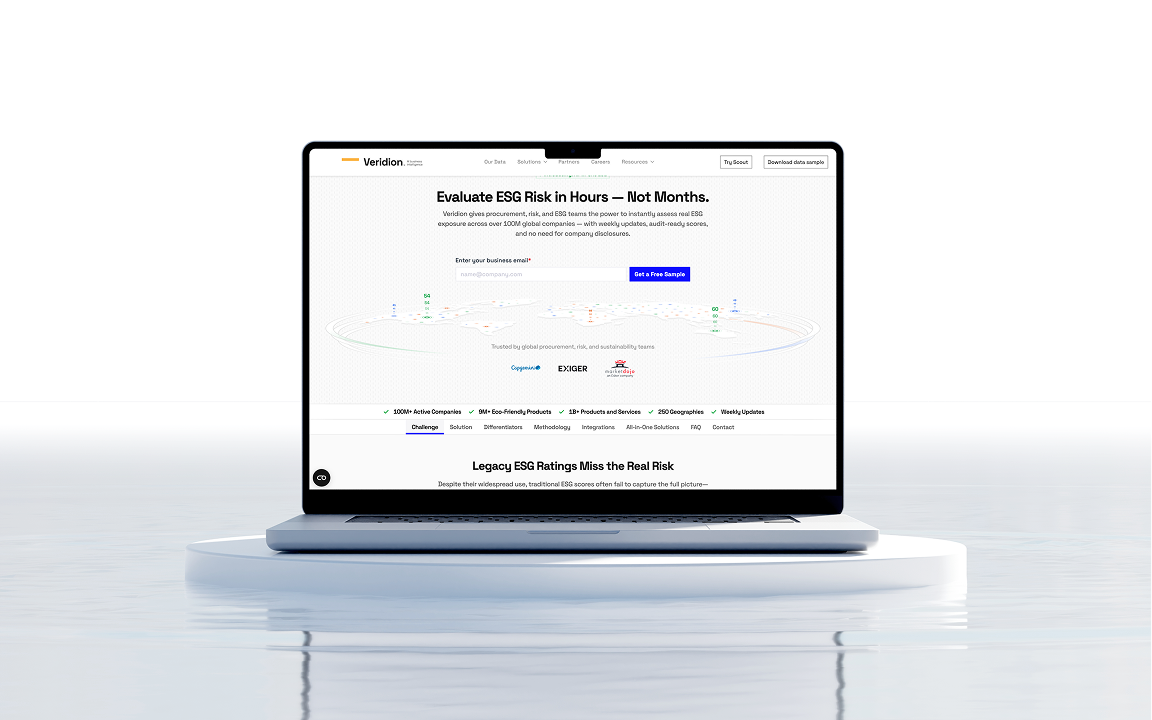
Action-Based ESG Data for Full Transparency
Get verifiable, audit-ready ESG data coverage.
Go beyond scores with granular risk factors.
Prioritize real actions for regulatory compliance.
Key Takeaways:
Collecting and leveraging ESG data isn’t just a regulatory compliance exercise—it’s a game-changer for procurement.
Companies that get it right reduce risk, improve supplier relationships, and build more sustainable supply chains.
But how can you collect this data in a structured and reliable way?
In this article, we’ll walk you through six practical steps to streamline ESG data collection and align it with your procurement strategy.
Before you start collecting data on environmental, social, and governance (ESG) factors, you need to establish clear ownership.
Without defined roles and responsibilities, ESG data collection can become inconsistent, incomplete, or deprioritized.
Procurement teams, sustainability officers, compliance departments, and data analysts all contribute, but who ensures the process runs smoothly?
That depends on how your ESG data ownership is structured.
In most large enterprises, ESG and sustainability reporting is guided by the Board of Directors and overseen by a high-level ESG Committee composed of senior executives.
They give direction, while different teams handle data collection, verification, and reporting.
Here’s a typical top-down ESG data governance structure:
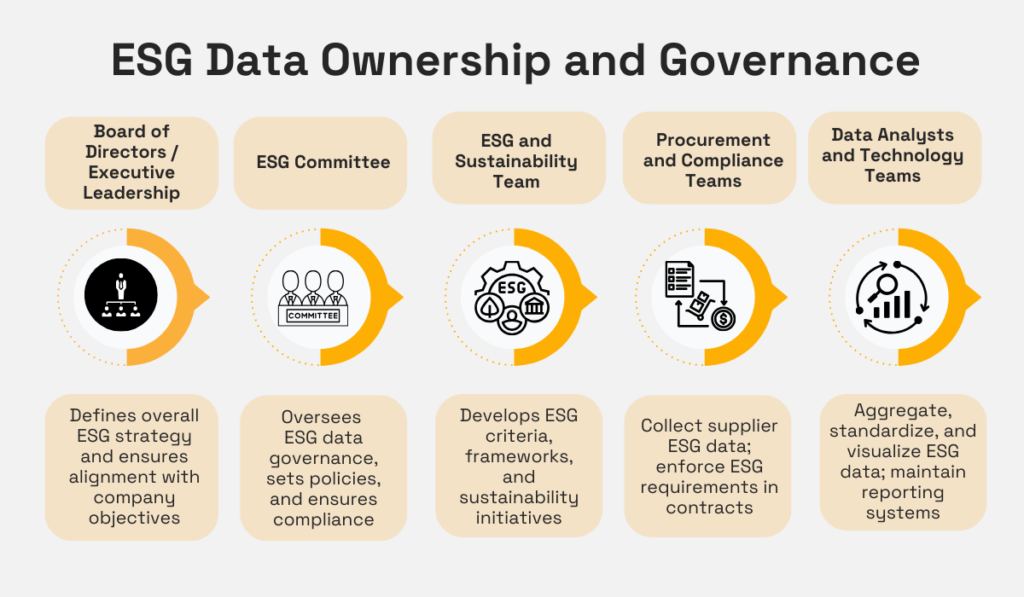
Source: Veridion
While this structure provides a general framework, organizations typically tailor their ESG data governance to meet their specific needs, size, and industry requirements.
Regardless of the governance setup, it’s important to define who is responsible for gathering, verifying, and maintaining ESG data within your company.
For example, the Chief Procurement Officer (CPO) typically oversees the integration of ESG factors into sourcing and supplier selection processes.
Their team handles the collection of supplier ESG data through RFPs, audits, and third-party sources, ensuring that suppliers meet ESG standards and comply with contract terms.
However, the CPO and their team are generally not responsible for ensuring the accessibility and management of ESG data.
As a recent Semarchy survey reveals, this responsibility typically falls to the Chief Data Officer (CDO) or a similar role.
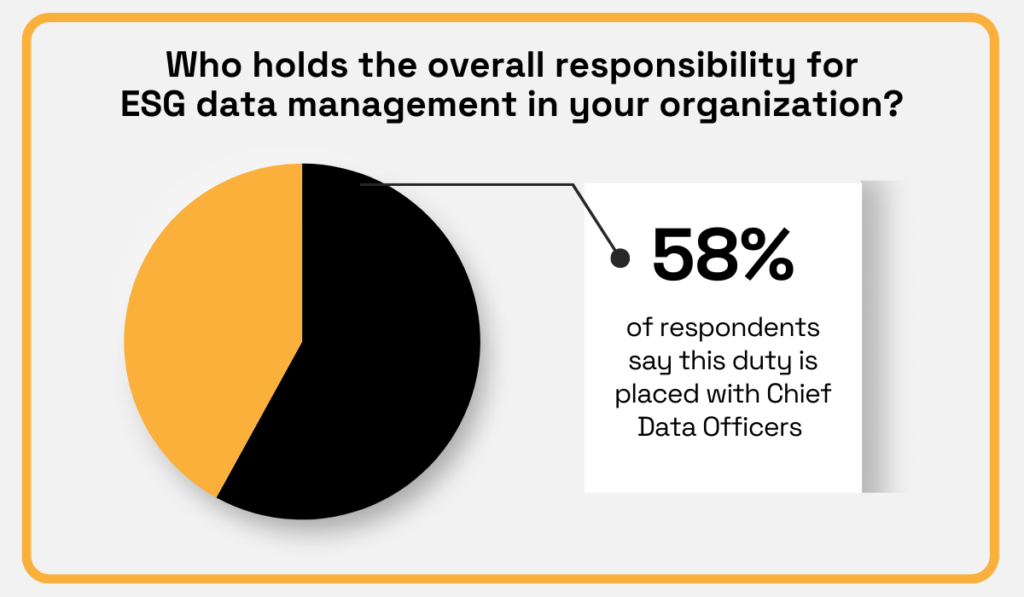
Illustration: Veridion / Data: Semarchy
No matter where the responsibility for ESG data ultimately sits, it’s clear that ESG data leaders need support from a cross-departmental, multifunctional team.
That’s because ESG policies, criteria, and data requirements cover a lot of ground and come from various sources.
Departments like finance, legal, operations, and marketing all play a key role when it comes to aligning both general and procurement-specific ESG requirements.
In short, strong cross-functional collaboration and executive buy-in are essential to make sure ESG data is prioritized and integrated into procurement processes.
Designating department-level ESG data coordinators as points of contact can help streamline the process and ensure clear communication across teams.
At the end of the day, while governance structures and specific responsibilities might differ, the goal is the same: clear ownership and accountability when it comes to collecting and managing ESG data.
Once you’ve established who owns the ESG data, the next step is to define the specific ESG factors that matter most to your organization.
These criteria are shaped by a mix of regulatory requirements, industry standards, and your company’s sustainability goals.
The key is ensuring they align with both compliance needs and strategic priorities.
At this stage, ESG factors are determined at the company-wide level, as they apply to all company operations, including suppliers.
As a result, many company-level ESG priorities naturally overlap with supplier-specific requirements.
To illustrate, here are some common ESG criteria used for both companies and their suppliers:
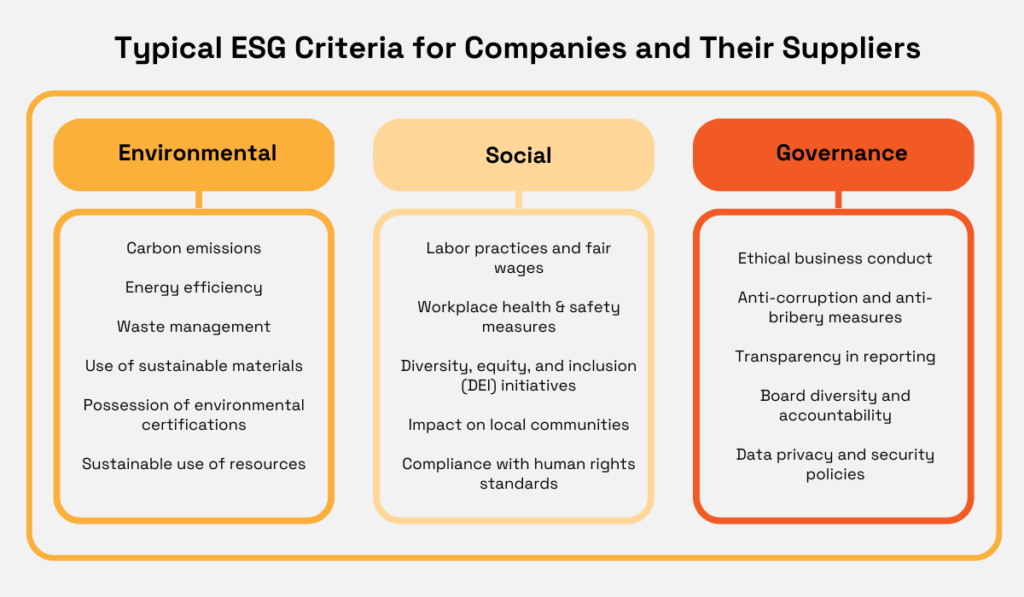
Source: Veridion
For example, if a company has a corporate goal of reducing its carbon footprint by 30% over the next five years, it must also consider supplier emissions as part of its overall impact.
This then needs to be converted into specific procurement criteria, such as requiring suppliers to:
As of 2024, emission reporting is mandatory under certain ESG regulations, like the EU Corporate Sustainability Reporting Directive (CSRD).
That’s why many companies now require suppliers to disclose emissions as a mandatory criterion.
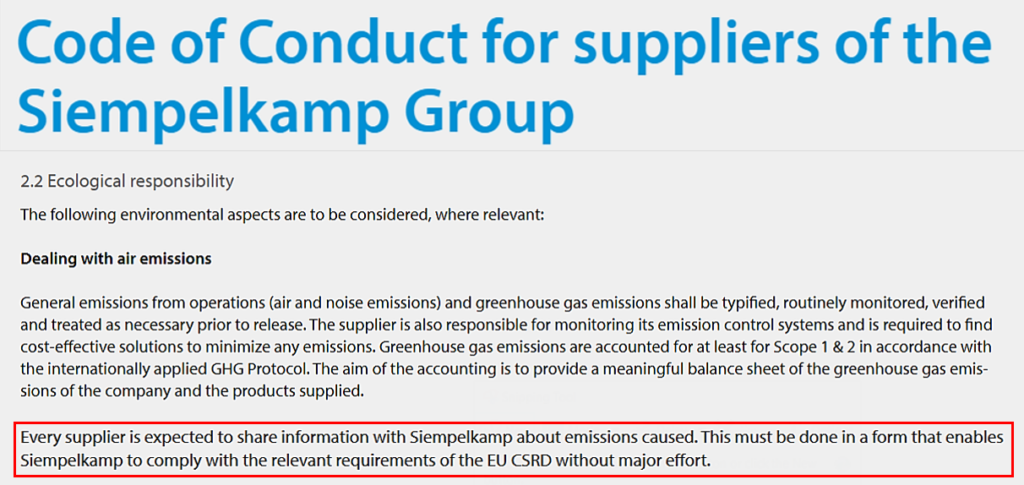
Source: Siempelkamp
The same criteria-setting principle applies to other ESG topics.
For example, companies may require suppliers to:
Since ESG criteria must be balanced with traditional procurement factors like quality, delivery, and price, defining them can be complex.
To simplify the process, follow these tips:
Ultimately, well-defined corporate ESG goals lead to clear supplier criteria, setting you up for the next step—supplier pre-screening.
In this step, you shortlist suppliers that meet high-level ESG requirements before conducting deeper assessments.
The goal is to filter out suppliers that do not meet basic ESG standards before investing in detailed data collection.
Common pre-screening methods include:
The first two methods require no direct supplier involvement, making them efficient for broad pre-screening.
Questionnaires, however, are useful when you already have a wide preliminary pool of potential suppliers and need more targeted insights.

Source: Sample Forms
To streamline ESG pre-screening, many companies use digital tools and databases, such as:
These tools help organizations automate risk identification.
For example, a company can automatically exclude suppliers flagged for human rights violations or those lacking essential environmental certifications.
One popular online platform is EcoVadis, which provides sustainability ratings for companies, with over 3 million suppliers screened and more than 150,000 rated.
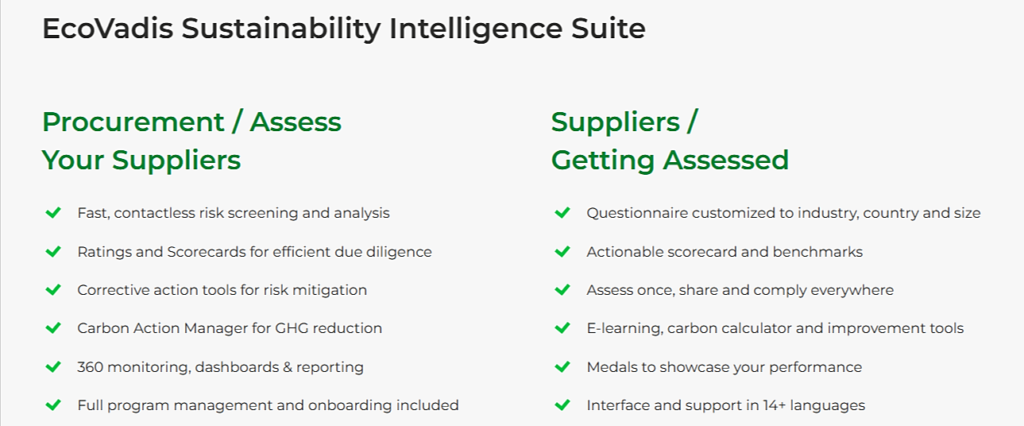
Source: EcoVadis
While such pre-screening tools and databases provide a strong starting point, they should be complemented by further assessments.
Why?
Some suppliers may lack third-party ratings despite having strong ESG practices, while others may hold certifications that don’t fully align with your company’s priorities.
That’s why ESG pre-screening should act as an initial filter—not a final decision-making tool.
Once a shortlist of compliant suppliers is established, the next step is to collect detailed ESG data from verifiable, high-quality sources.
Not all ESG data sources are equally reliable, so distinguishing between trusted sources and those requiring additional verification is crucial.
Highly trusted sources typically include:
These sources help verify less reliable data, such as self-reported supplier questionnaires.
To streamline this process, companies can use AI-powered platforms like Veridion to automate ESG data collection and verification.
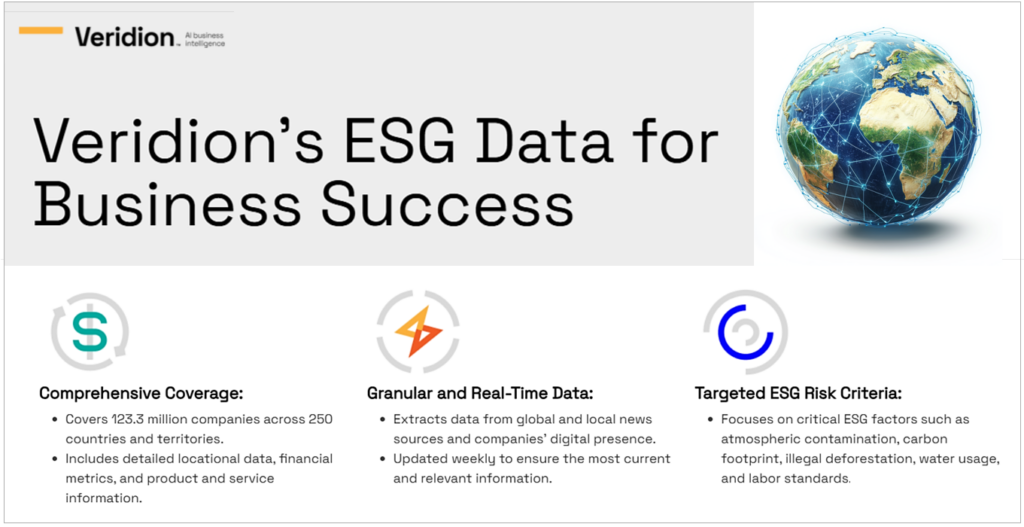
Source: Veridion
Veridion’s AI-powered bots collect all relevant information, including ESG data, on all companies worldwide with an active online presence.
Veridion’s global database is updated weekly, currently covering over 123 million companies across 250 geographies.
A particular focus is given to critical ESG factors like carbon footprint, water usage, ethical labor practices, and more.
You can view the full list of ESG topics and risk criteria covered by Veridion here.
All these features create a universe of Veridion data that provides unparalleled global coverage of accurate, up-to-date supplier information.
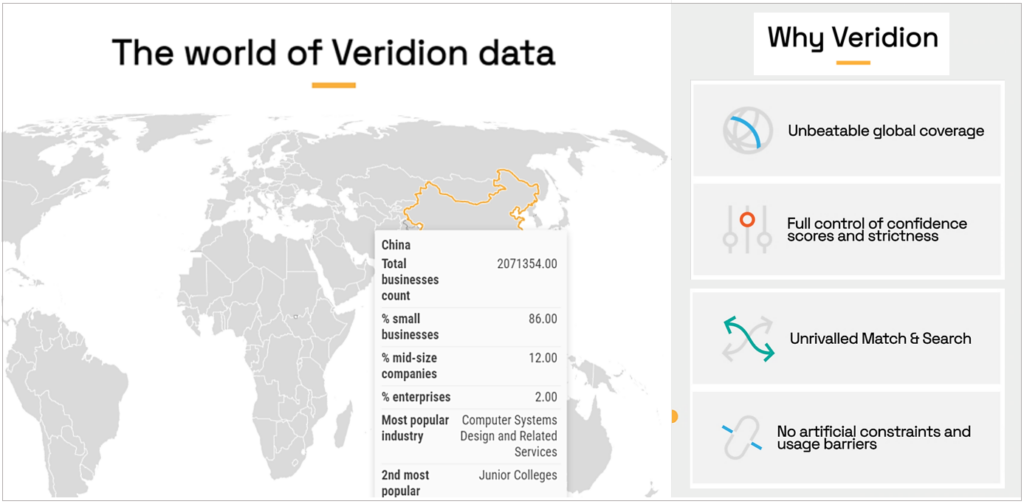
Source: Veridion
This wealth of structured, verified data can be searched using natural language via our online search engine, Scout, or APIs that integrate Veridion with your other systems.
As a result, your team can:
These supplier discovery, filtering, and data verification features are essential for collecting accurate, reliable ESG data and making faster, data-driven decisions.
Both for existing and new suppliers, this can help ensure compliant ESG reporting while avoiding risks like a supplier’s greenwashing or unethical labor practices.
However, to extract actionable insights from all this ESG data, visualizing it is key.
Given all the types and sources of ESG data, collecting it without visualization would result in work overload and analysis paralysis.
Since procurement teams often deal with large datasets, this makes it challenging to extract key takeaways quickly.
Software dashboards can provide an intuitive way to assess and track supplier ESG performance, enabling teams to compare suppliers and pinpoint risks.
Well-designed ESG dashboards aggregate key supplier metrics—such as carbon emissions, labor policies, and compliance scores—into a centralized view.
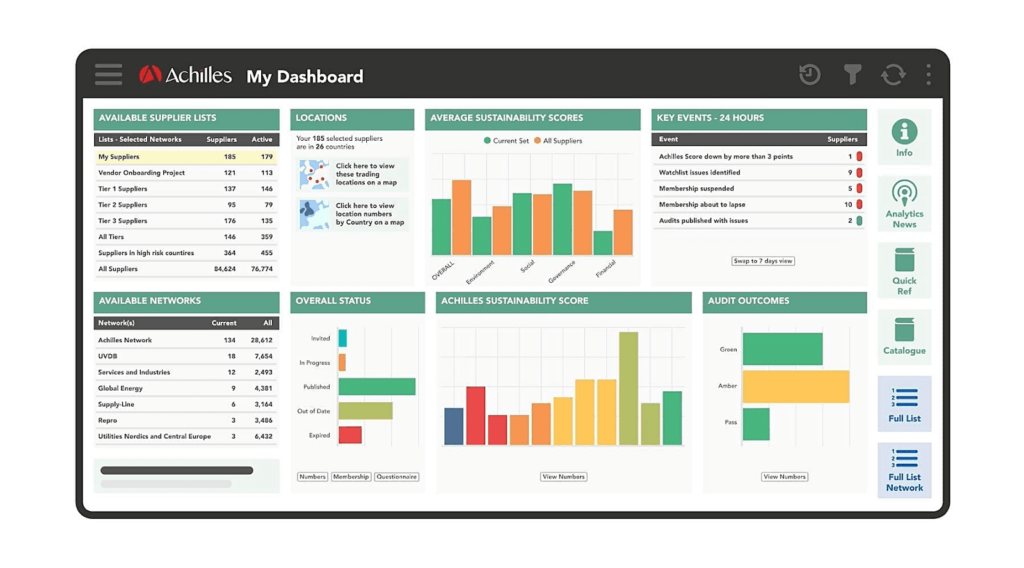
Source: Achilles
Such dashboards can simplify decision-making by offering a clear snapshot of sustainability performance across your supply chain.
Beyond dashboards, ESG risk matrices and heat maps offer additional ways to analyze supplier sustainability performance and broader, country- or sector-specific ESG risks.
Heat maps can visually highlight high ESG risk areas, such as regions or industries with poor sustainability records, helping teams look beyond supplier-specific risks.
For example, this 2019 overview of ESG performance by country illustrates how related risks vary across different regions.
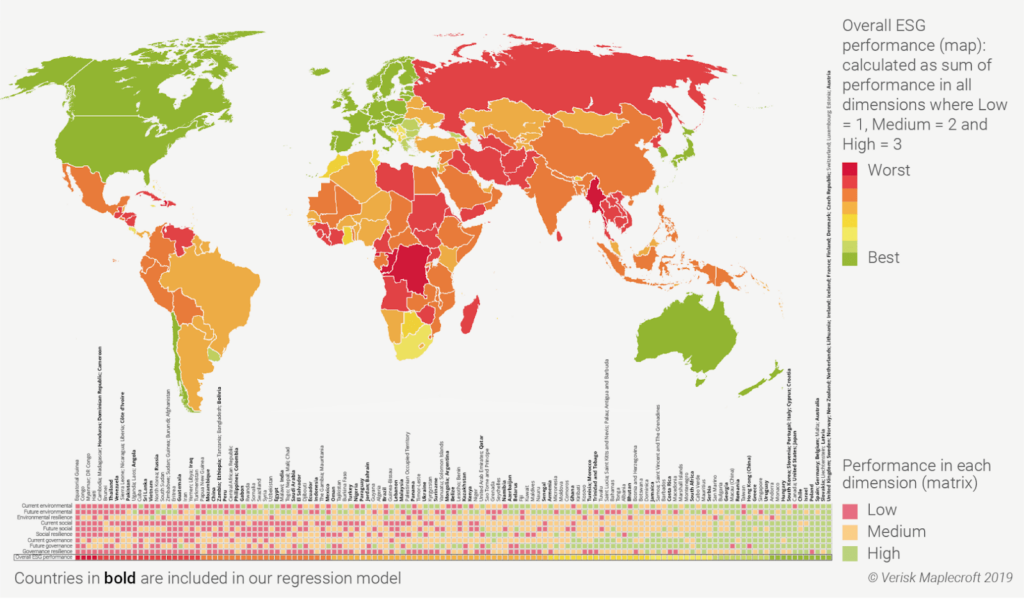
Source: Maplecroft
Such maps are especially useful when granular data is lacking, helping procurement teams prioritize suppliers for further due diligence or ESG-specific monitoring.
Meanwhile, ESG scorecards are a tool that provides individual supplier ratings based on predefined sustainability criteria.
By consolidating key factors—environmental impact, social responsibility, and governance practices—scorecards enable quick supplier comparisons and track improvements over time.

Source: Brighest.io
Just like dashboards, ESG scorecards summarize complex data, helping teams make informed sourcing and supplier management decisions aligned with corporate sustainability goals.
In summary, data visualization tools make it easier to evaluate supplier ESG performance, monitor compliance, and mitigate risks.
Of course, none of this is possible without a centralized ESG data repository accessible to all stakeholders.
Given the vast amount of ESG data, organizing it in a centralized, accessible system is essential.
Since many ESG data points relate to suppliers, this process typically starts with consolidating all supplier data in one place.
Otherwise, procurement teams risk data silos, inconsistencies, and inefficiencies that compromise supplier sustainability assessments.
Supplier master data management solutions, like HICX and Kodiak Hub, simplify this process by integrating multiple sources of supplier data (ESG included) into a single platform.
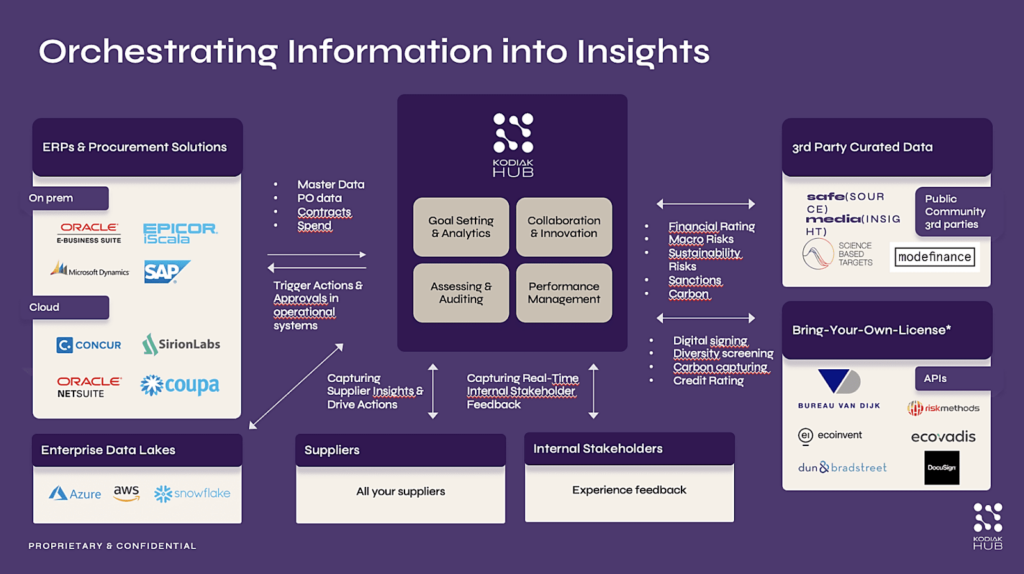
Source: Kodiak Hub
The end result of this data consolidation is a unified view of each supplier’s performance, including ESG factors.
However, ESG data extends beyond suppliers, so it must be combined with a company’s own sustainability metrics, financial reports, and regulatory disclosures.
This is where specialized ESG reporting solutions come in, allowing companies to produce compliant ESG reports across multiple reporting frameworks.
For instance, IBM Envizi enables businesses to generate reports aligned with major ESG frameworks, including UN SDGs, GRI, SASB, and ESRS (CSRD) using a single dataset.

Source: IBM Envizi
This cross-framework capability saves time and effort, enabling teams to enter ESG data once and generate reports across multiple frameworks.
To sum up, organizing supplier ESG data in a centralized, accessible system ensures procurement teams have real-time insights for better decision-making.
At the same time, ESG reporting software helps ensure compliance with changing regulations and reporting standards, enabling organizations to meet both compliance requirements and investor expectations.
Collecting and managing ESG data is essential for sustainable procurement, regulatory compliance, and meeting stakeholder expectations.
The process begins with defining clear roles and ESG criteria, followed by supplier pre-screening, reliable data collection, visualization, and centralization.
Leveraging software tools and market intelligence platforms streamlines these steps, ensuring accurate insights and efficient reporting.
As ESG expectations continue to rise, investing in structured, accessible ESG data management will be key to staying ahead and making informed, responsible sourcing decisions.